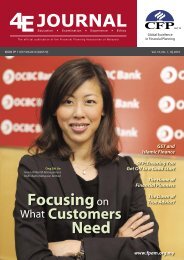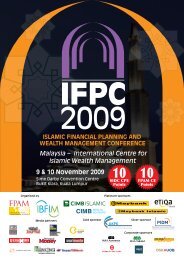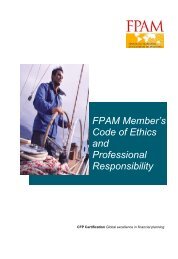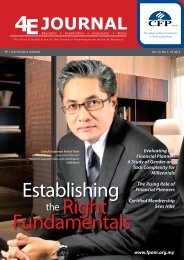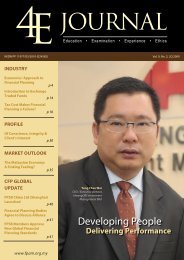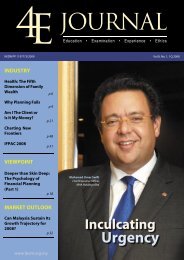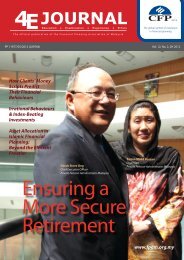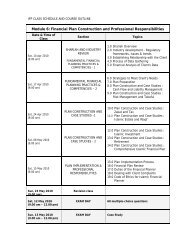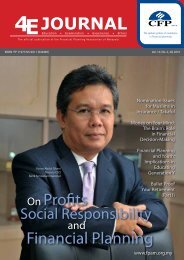Vol 10, No 3 - Financial Planning Association of Malaysia
Vol 10, No 3 - Financial Planning Association of Malaysia
Vol 10, No 3 - Financial Planning Association of Malaysia
You also want an ePaper? Increase the reach of your titles
YUMPU automatically turns print PDFs into web optimized ePapers that Google loves.
Traditional Family Practice <strong>of</strong><br />
Filial Piety Evolving<br />
Traditionally, the elderly in Asia expect<br />
their children to look after them during<br />
old age and more <strong>of</strong>ten than not stay with<br />
their children.<br />
The children, whilst realising the many<br />
practical issues and challenges <strong>of</strong> keeping<br />
their parents in their homes, are reluctant<br />
to accept the concept <strong>of</strong> retirement living<br />
as a better living alternative for their<br />
parents.<br />
This reluctance is due to the perception<br />
<strong>of</strong> their filial duty to their ageing parents.<br />
Allowing them to live in retirement<br />
villages is <strong>of</strong>ten seen as a neglect <strong>of</strong> their<br />
filial duty and hence a loss <strong>of</strong> face.<br />
However, this traditional practice is fast<br />
evolving with changing global conditions<br />
as revealed by one inter-generational<br />
study undertaken in Asia recently. This<br />
study revealed that children are starting<br />
to appreciate and accept living in<br />
retirement villages/nursing homes as a<br />
socially acceptable alternative for their<br />
parents. They are starting to appreciate<br />
and embrace the reality that by allowing<br />
and encouraging their parents to live in<br />
retirement villages/nursing homes is in fact<br />
an act <strong>of</strong> filial piety without any loss <strong>of</strong> face.<br />
The various research undertaken over<br />
the last few years suggest that more and<br />
more elderly <strong>Malaysia</strong>ns prefer to live<br />
independently. Retirement villages could<br />
provide the alternative lifestyle choice<br />
they are looking for.<br />
What is a Retirement Village?<br />
The idea <strong>of</strong> the retirement village has<br />
developed from the need to provide an<br />
alternative lifestyle choice for members<br />
<strong>of</strong> the community who have reached<br />
retirement age. The aim is to create a<br />
secure environment where people can<br />
socialise and mix with those <strong>of</strong> their own<br />
age, thus helping to remove some <strong>of</strong> the<br />
loneliness and boredom <strong>of</strong>ten associated<br />
with growing old.<br />
The trend in retirement village development<br />
in Australia and other developed economies<br />
Residential Aged Care Facility<br />
is towards a resort lifestyle model that <strong>of</strong>fers<br />
a range <strong>of</strong> lifestyle activities and services to<br />
its residents. Also more and more residents<br />
are looking for developments that have<br />
or have ready access to aged care (nursing<br />
home) facilities.<br />
Such “ageing-in-place” development<br />
<strong>of</strong>fers the residents the opportunity to<br />
age gracefully and with dignity and where<br />
their changing care needs over time can<br />
be met at one familiar location.<br />
Retirement village developments with<br />
on-site aged care facilities are able<br />
Retirement Village<br />
Ageing-In-Place Development<br />
Where the retirement village and<br />
the aged care facility are co-located<br />
in one location – residents<br />
changing care needs over time are<br />
met in one familiar place.<br />
16 The 4E Journal



